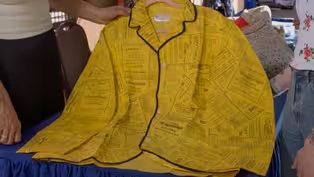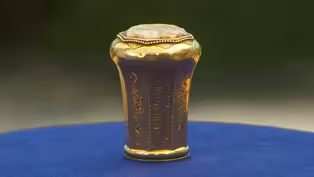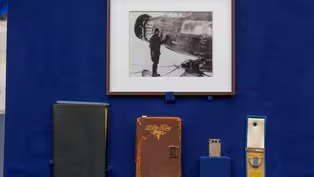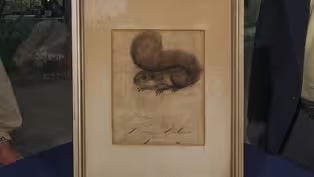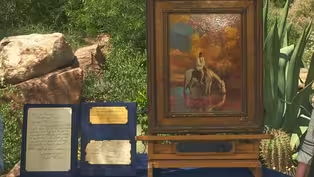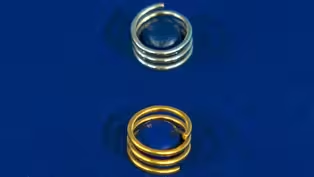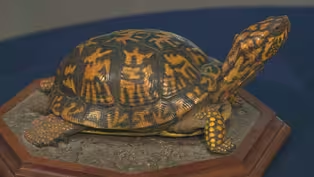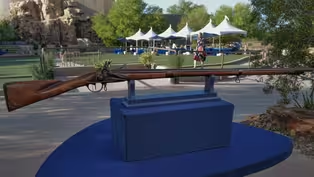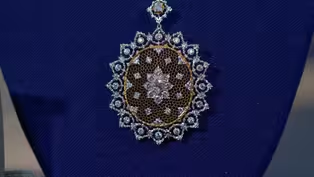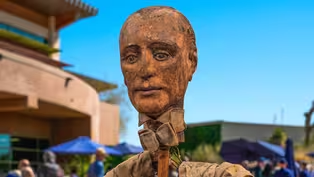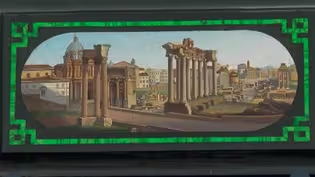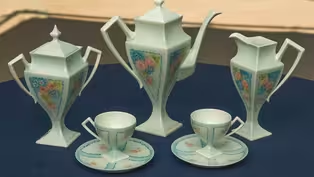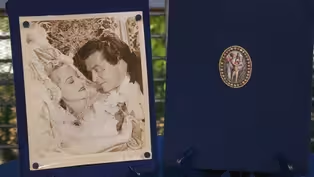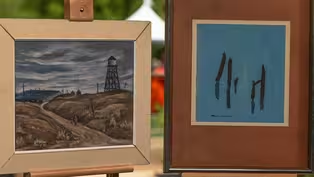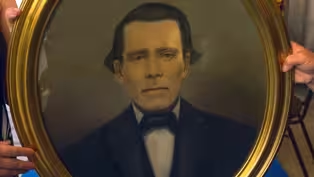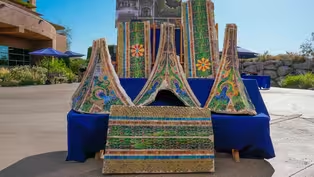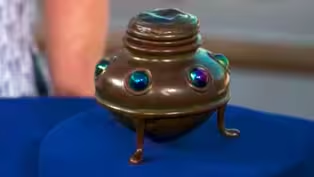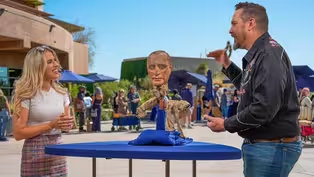
Appraisal: Formerly Enslaved Woman's Apron, ca. 1900
Clip: Season 29 Episode 5 | 4m 15sVideo has Closed Captions
Appraisal: Formerly Enslaved Woman's Apron, ca. 1900
See Martina D'Amato appraise a formerly enslaved woman's apron, ca. 1900, in Springs Preserve, Hour 2.
Problems playing video? | Closed Captioning Feedback
Problems playing video? | Closed Captioning Feedback
Funding for ANTIQUES ROADSHOW is provided by Ancestry and American Cruise Lines. Additional funding is provided by public television viewers.

Appraisal: Formerly Enslaved Woman's Apron, ca. 1900
Clip: Season 29 Episode 5 | 4m 15sVideo has Closed Captions
See Martina D'Amato appraise a formerly enslaved woman's apron, ca. 1900, in Springs Preserve, Hour 2.
Problems playing video? | Closed Captioning Feedback
How to Watch Antiques Roadshow
Antiques Roadshow is available to stream on pbs.org and the free PBS App, available on iPhone, Apple TV, Android TV, Android smartphones, Amazon Fire TV, Amazon Fire Tablet, Roku, Samsung Smart TV, and Vizio.
Buy Now

ANTIQUES ROADSHOW 2025 Tour!
Enter now for a chance to win free tickets to ANTIQUES ROADSHOW's 2025 Tour! Plus, see which cities we're headed to!Providing Support for PBS.org
Learn Moreabout PBS online sponsorshipGUEST: This is my great-great-grandmother's apron.
My great-great-grandmother was freed from slavery when she was 12 years old, and the apron has been in the family ever since.
My mother gave it to me with no explanation.
My family was from Austin, Texas.
I don't know that that's where the great-great-grandmother was enslaved.
Because back in the day when I grew up, folks didn't talk.
And not only did they not talk, children were not encouraged to ask questions.
I do know that when Grandma, Great-Great-Grandma, the owner of the apron, did try to tell stories about her life on the plantation, family members said, "Oh, don't nobody want to hear about all that stuff."
APPRAISER: Do you know your great-great-grandmother's name, or anything else?
GUEST: I known, I, I've, I've told you what I know.
APPRAISER: Oh.
But you've also brought this photo today.
GUEST: My mother also gave me the photo, and that is Great-Great-Grandmother, and that is me when I was two years old.
So that makes it 85 years ago.
And I wasn't a nice little kid, because I was bothered a lot by old people.
(chuckles) Never realizing that I was going to be old one day.
APPRAISER: So what year would this photo have been taken?
GUEST: That would be 1939.
APPRAISER: So your great-great-grandmother would have been about your age, a l, a few years older, in this photo.
GUEST: Uh-huh.
Oh, I hadn't thought of it that way, thanks.
APPRAISER: Yeah.
(both laughing) APPRAISER: What an amazing document.
Looking at the fabric, looking at the embroidery and the size of it-- we h, we see it a little folded here, but it's a bit longer-- those all tell us that your great-great-grandmother probably made and wore this a little bit later in life.
It is an adult woman's apron.
This is a very small, patterned gingham cotton plain weave, and a fabric like that could have been produced anywhere from the mid-19th into the first two decades of the 20th century.
And the design itself of the, the pattern is actually an Indian design.
Ginghams like this, plaid gingham, came from Madras, India.
GUEST: Oh, okay.
APPRAISER: So in the, in the, uh, late 18th and early 19th centuries, and it was imported in huge quantities to America.
GUEST: Mm-hmm.
APPRAISER: And then Americans began weaving their own.
She took the time to embroider it all over the hem and the pockets with this amazing cross-stitch in cotton thread.
It has both machine stitching, but there's also evidence of hand stitching, in addition to the hand embroidery.
So it's possible that your great-great-grandmother bought the apron as it was and embroidered it or even bought it with embroidery.
But it's also entirely possible that she made the garment herself from fabric that she purchased.
The one element that kind of helps to date it as closely as I can are the pockets.
They're a really unusual shape.
You see these pockets in pattern books for aprons and pinafores around the year 1900.
It's a different kind of cotton than what you can get now, that's for sure, and you can feel it, the higher quality.
It was meant to last.
GUEST: And it has definitely lasted.
APPRAISER: What would you think this would be worth?
GUEST: $300.
APPRAISER: In a shop specializing in historical clothing, I might expect to see it for maybe $50, $75.
Aprons are not rare.
But with your family's history, with this photograph, I could easily see this selling in a retail setting for about ten times that.
GUEST: Oh!
APPRAISER: So probably somewhere in the range of $700 conservatively.
If a genealogist were to work on your family history, with a family tree, I could easily see even that figure doubling and probably going for as much as $1,500 to $2,000.
GUEST: Well, I think I'll go genealogy route.
(laughs) I need to know more.
Appraisal: Paper Men's Jacket, ca. 1965
Video has Closed Captions
Clip: S29 Ep5 | 51s | Appraisal: Paper Men's Jacket, ca. 1965 (51s)
Appraisal: 1861 Presentation Gold Letter Seal
Video has Closed Captions
Clip: S29 Ep5 | 1m 55s | Appraisal: 1861 Presentation Gold Letter Seal (1m 55s)
Appraisal: 1928 - 1930 R.E. Byrd Antarctic Expedition Group
Video has Closed Captions
Clip: S29 Ep5 | 3m 17s | Appraisal: 1928 - 1930 R.E. Byrd Antarctic Expedition Group (3m 17s)
Appraisal: 1933 Barney Nelson Crayon Drawing
Video has Closed Captions
Clip: S29 Ep5 | 1m 53s | Appraisal: 1933 Barney Nelson Crayon Drawing (1m 53s)
Appraisal: Bert Phillips Oil Painting, ca. 1935
Video has Closed Captions
Clip: S29 Ep5 | 2m 43s | Appraisal: Bert Phillips Oil Painting, ca. 1935 (2m 43s)
Appraisal: Dinh Van-designed Cartier Gold Ring, ca. 1955
Video has Closed Captions
Clip: S29 Ep5 | 2m 6s | Appraisal: Dinh Van-designed Cartier Gold Ring, ca. 1955 (2m 6s)
Appraisal: Doug Eppes Eastern Box Turtle Carving, ca. 1975
Video has Closed Captions
Clip: S29 Ep5 | 2m 34s | Appraisal: Doug Eppes Eastern Box Turtle Carving, ca. 1975 (2m 34s)
Appraisal: French Model 1763/66 Musket, ca. 1770
Video has Closed Captions
Clip: S29 Ep5 | 3m 19s | Appraisal: French Model 1763/66 Musket, ca. 1770 (3m 19s)
Appraisal: Gianmaria Buccellati Diamond & Gold Necklace, ca. 1972
Video has Closed Captions
Clip: S29 Ep5 | 3m 1s | Appraisal: Gianmaria Buccellati Diamond & Gold Necklace, ca. 1972 (3m 1s)
Appraisal: Harry Kellar Illusion Head, ca. 1900
Video has Closed Captions
Clip: S29 Ep5 | 3m 53s | Appraisal: Harry Kellar Illusion Head, ca. 1900 (3m 53s)
Appraisal: Italian Micromosaic, ca. 1870
Video has Closed Captions
Clip: S29 Ep5 | 2m 24s | Appraisal: Italian Micromosaic, ca. 1870 (2m 24s)
Appraisal: Limoges China-painted Coffee Set, ca. 1925
Video has Closed Captions
Clip: S29 Ep5 | 2m 15s | Appraisal: Limoges China-painted Coffee Set, ca. 1925 (2m 15s)
Appraisal: Paulette Goddard-worn Joseff of Hollywood Brooch
Video has Closed Captions
Clip: S29 Ep5 | 2m 14s | Appraisal: Paulette Goddard-worn Joseff of Hollywood Brooch (2m 14s)
Appraisal: Paul Horiuchi Oil Painting & Collage
Video has Closed Captions
Clip: S29 Ep5 | 3m 58s | Appraisal: Paul Horiuchi Oil Painting & Collage (3m 58s)
Appraisal: Sun Enlargement Photo & Bubble Glass Frame, ca. 1900
Video has Closed Captions
Clip: S29 Ep5 | 1m 3s | Appraisal: Sun Enlargement Photo & Bubble Glass Frame, ca. 1900 (1m 3s)
Appraisal: Tiffany Glass Mosaics, ca. 1915
Video has Closed Captions
Clip: S29 Ep5 | 2m 33s | Appraisal: Tiffany Glass Mosaics, ca. 1915 (2m 33s)
Appraisal: Tiffany Studios Bronze & Glass Inkstand, ca. 1903
Video has Closed Captions
Clip: S29 Ep5 | 1m 48s | Appraisal: Tiffany Studios Bronze & Glass Inkstand, ca. 1903 (1m 48s)
Preview: Springs Preserve, Hour 2
Video has Closed Captions
Preview: S29 Ep5 | 30s | Preview: Springs Preserve, Hour 2 (30s)
Providing Support for PBS.org
Learn Moreabout PBS online sponsorshipSupport for PBS provided by:
Funding for ANTIQUES ROADSHOW is provided by Ancestry and American Cruise Lines. Additional funding is provided by public television viewers.


